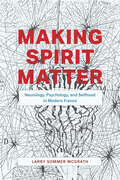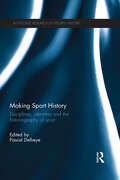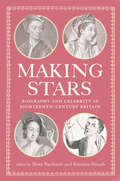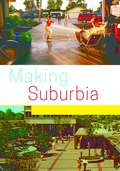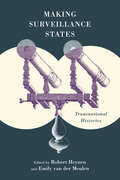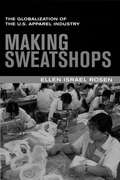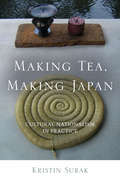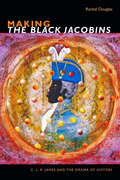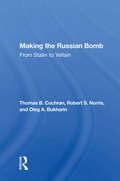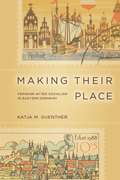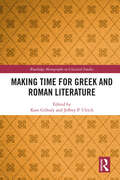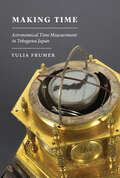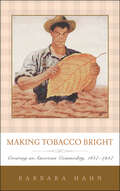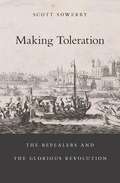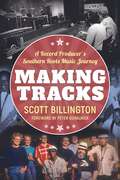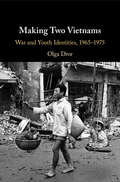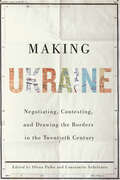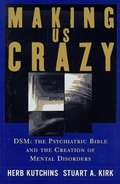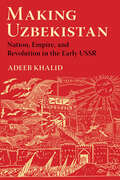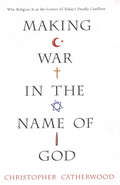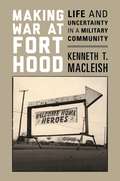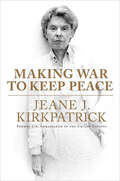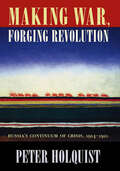- Table View
- List View
Making Spirit Matter: Neurology, Psychology, and Selfhood in Modern France
by Larry Sommer McGrathThe connection between mind and brain has been one of the most persistent problems in modern Western thought; even recent advances in neuroscience haven’t been able to explain it satisfactorily. Historian Larry Sommer McGrath’s Making Spirit Matter studies how a particularly productive and influential group of nineteenth- and early twentieth-century French thinkers attempted to solve this puzzle by showing the mutual dependence of spirit and matter. The scientific revolution taking place at this point in history across disciplines, from biology to psychology and neurology, located our mental powers in the brain and offered a radical reformulation of the meaning of society, spirit, and the self. Tracing connections among thinkers such as Henri Bergson, Alfred Fouillée, Jean-Marie Guyau, and others, McGrath plots alternative intellectual movements that revived themes of creativity, time, and experience by applying the very sciences that seemed to undermine metaphysics and religion. Making Spirit Matter lays out the long legacy of this moment in the history of ideas and how it might renew our understanding of the relationship between mind and brain today.
Making Sport History: Disciplines, identities and the historiography of sport (Routledge Research in Sports History)
by Pascal DelheyeThe field of sport history is a relatively new research domain, situated at the intersection of a number of disciplines and sub-disciplines. This interdisciplinarity has created interesting avenues for growth and fresh thinking but also inherent problems of coherence and identity. Making Sport History examines the development of an academic community around sport history, exploring the roots of the discipline, its current boundaries, borders and challenges, and looking ahead at future prospects. Written by a team of world-leading sport historians, with commentaries from scholars working outside of the sport historical mainstream, the book considers key themes in the historiography of sport, including: The relationship between history, sport studies and physical education Comparative analysis of the role of historians in the writing of sport history Modern and post-modern approaches to sport history Race, gender and the sport historical establishment The role of scholarly organisations, conferences and journals in discipline-building Presenting new perspectives on what constitutes sport history and its core methodologies, the book helps explain why historians have become interested in sport, why they’ve chosen the topics they have, and how their work has influenced the wider world of history and been influenced by it. Making Sport History is essential reading for any advanced student, scholar or researcher with an interest in sport history, historiography, or the history and philosophy of the social sciences.
Making Stars: Biography and Celebrity in Eighteenth-Century Britain (Performing Celebrity)
by Glynis Ridley Stuart Sherman Jack Lynch Rebecca Tierney-Hynes Sarah Ailwood Miriam L. Wallace Sören Hammerschmidt Jane Wessel Heather McPherson Elaine McGirr Semane Parsons Kevin Bourque Anne Betty Weinshenker Teri Doerksen Kirsten Teresa SaxtonIn bringing biography and celebrity together, the essays in Making Stars interrogate contemporary and current understandings of each. Although biography was not invented in the eighteenth century, the period saw the emergence of works that focus on individuals who are interesting as much, if not more, for their everyday, lived experience than for their status or actions. At the same time, celebrity emerged as public fascination for the private lives of publicly visible individuals. Biography and celebrity are mutually constitutive, but in complex and varied ways that this volume unpacks. Contributors to this volume present us a picture of eighteenth-century celebrity that was mediated across multiple sites, demonstrating that eighteenth-century celebrity culture in Britain was more pervasive, diverse and, in many ways, more egalitarian, than previously supposed.
Making Suburbia: New Histories of Everyday America
by Katherine Solomonson John Archer Paul J. P. SandulWhat are the suburbs? The popular vision of monotonous streets curving into culs-de-sac and emerald lawns unfurling from nearly identical houses would have us believe that suburbia is a boring, homogeneous, and alienating place. But this stereotypical portrayal of the suburbs tells us very little about the lives of the people who actually live there. Making Suburbia offers a diverse collection of essays that examine how the history and landscape of the American suburb is constructed through the everyday actions and experiences of its inhabitants.From home decor and garage rock to modernist shopping malls and holiday parades, contributors explore how suburbanites actively created the spaces of suburbia. The volume is divided into four parts, each of which addresses a distinct aspect of the ways in which suburbia is lived in and made. More than twenty essays range from Becky Nicolaides&’s chronicle of cross-racial alliances in Pasadena, to Jodi Rios&’s investigation of St. Louis residents&’ debates over public space and behavior, to Andrew Friedman&’s story of Cold War double agents who used the suburban milieu as a cover for their espionage.Presenting a wide variety of voices, Making Suburbia reveals that suburbs are a constantly evolving landscape for the articulation of American society and are ultimately defined not by planners but by their inhabitants.Contributors: Anna Vemer Andrzejewski, U of Wisconsin–Madison; Heather Bailey, History Colorado State Historical Fund; Gretchen Buggeln, Valparaiso U; Charity R. Carney, Western Governors U; Martin Dines, Kingston U London; Andrew Friedman, Haverford College; Beverly K. Grindstaff, San José State U; Dianne Harris, U of Illinois, Urbana–Champaign; Ursula Lang, U of Minnesota; Matthew Gordon Lasner, Hunter College; Willow Lung-Amam, U of Maryland, College Park; Becky Nicolaides, U of California, Los Angeles; Trecia Pottinger, Oberlin College; Tim Retzloff, Michigan State U; Jodi Rios, U of California, Berkeley; Christopher Sellers, Stony Brook U; David Smiley, Columbia U; Stacie Taranto, Ramapo College of New Jersey; Steve Waksman, Smith College; Holley Wlodarczyk, U of Minnesota.
Making Surveillance States: Transnational Histories
Making Surveillance States: Transnational Histories opens up new and exciting perspectives on how systems of state surveillance developed over the nineteenth and twentieth centuries. Taking a transnational approach, the book challenges us to rethink the presumed novelty of contemporary surveillance practices, while developing critical analyses of the ways in which state surveillance has profoundly shaped the emergence of contemporary societies. Contributors engage with a range of surveillance practices, including medical and disease surveillance, systems of documentation and identification, and policing and security. These approaches enable us to understand how surveillance has underpinned the emergence of modern states; sustained systems of state security; enabled practices of colonial rule; perpetuated racist and gendered forms of identification and classification; regulated and policed migration; shaped the eugenically inflected medicalization of disability and sexuality; and contained dissent. While surveillance is thus bound up with complex relations of power, it is also contested. Emerging from the book is a sense of how state actors understood and legitimized their own surveillance practices, as well as how these practices have been implemented in different times and places. At the same time, contributors explore the myriad ways in which these systems of surveillance have been resisted, challenged, and subverted.
Making Sweatshops: The Globalization of the U. S. Apparel Industry
by Ellen Israel RosenA comprehensive historical analysis of the globalization of the U.S. apparel industry, this book focuses on the re-emergence of sweatshops in the United States and the growth of new ones abroad.
Making Tea, Making Japan: Cultural Nationalism in Practice
by Kristin SurakThe tea ceremony persists as one of the most evocative symbols of Japan. Originally a pastime of elite warriors in premodern society, it was later recast as an emblem of the modern Japanese state, only to be transformed again into its current incarnation, largely the hobby of middle-class housewives. How does the cultural practice of a few come to represent a nation as a whole? Although few non-Japanese scholars have peered behind the walls of a tea room, sociologist Kristin Surak came to know the inner workings of the tea world over the course of ten years of tea training. Here she offers the first comprehensive analysis of the practice that includes new material on its historical changes, a detailed excavation of its institutional organization, and a careful examination of what she terms "nation-work"-the labor that connects the national meanings of a cultural practice and the actual experience and enactment of it. She concludes by placing tea ceremony in comparative perspective, drawing on other expressions of nation-work, such as gymnastics and music, in Europe and Asia. Taking readers on a rare journey into the elusive world of tea ceremony, Surak offers an insightful account of the fundamental processes of modernity-the work of making nations.
Making Thatcher's Britain
by Ben Jackson Robert SaundersMargaret Thatcher was one of the most controversial figures of modern times. Her governments inspired hatred and veneration in equal measure and her legacy remains fiercely contested. Yet assessments of the Thatcher era are often divorced from any larger historical perspective. This book draws together leading historians to locate Thatcher and Thatcherism within the political, social, cultural and economic history of modern Britain. It explores the social and economic crises of the 1970s; Britain's relationships with Europe, the Commonwealth and the United States; and the different experiences of Thatcherism in Scotland, Wales and Northern Ireland. The book assesses the impact of the Thatcher era on class and gender and situates Thatcherism within the Cold War, the end of Empire and the rise of an Anglo-American 'New Right'. Drawing on the latest available sources, it opens a wide-ranging debate about the Thatcher era and its place in modern British history.
Making The Black Jacobins: C. L. R. James and the Drama of History (The C. L. R. James Archives)
by Rachel DouglasC. L. R. James's The Black Jacobins remains one of the great works of the twentieth century and the cornerstone of Haitian revolutionary studies. In Making The Black Jacobins, Rachel Douglas traces the genesis, transformation, and afterlives of James's landmark work across the decades from the 1930s on. Examining the 1938 and 1963 editions of The Black Jacobins, the 1967 play of the same name, and James's 1936 play, Toussaint Louverture—as well as manuscripts, notes, interviews, and other texts—Douglas shows how James continuously rewrote and revised his history of the Haitian Revolution as his politics and engagement with Marxism evolved. She also points to the vital significance theater played in James's work and how it influenced his views of history. Douglas shows The Black Jacobins to be a palimpsest, its successive layers of rewriting renewing its call to new generations.
Making The Russian Bomb: From Stalin To Yeltsin
by Thomas B. CochranThe Natural Resources Defense Council once again provides the definitive account of the current status of Russian nuclear weapons. Taking advantage of previously unavailable information the authors describe the origins, growth, and decline of the massive Soviet nuclear weapons production complex-the places involved in the recent headline-making epi
Making Their Place: Feminism After Socialism in Eastern Germany
by Katja GuentherThe collapse of state socialism in eastern and central Europe in 1989 had a dramatic impact on women. Witnessing the loss of state support for their economic activity, the curtailing of their reproductive rights, and the rise of gender ideologies that value women primarily as mothers and wives rather than as active participants in the workforce, women across eastern and central Europe organized on a local level to resist these changes. Making Their Place brings to light how feminist movements in two eastern German cities, Erfurt and Rostock, utilized local understandings of politics and gender to enhance their possibilities for meaningful social change. The book chronicles the specific reasons why place matters, the importance of localized experiences during the socialist era, and how history shapes contemporary identities, cultures, and politics. What emerges is the fascinating story of the different ways people have struggled to define themselves, their values, and their understandings of gender in a period of monumental social, economic, and political upheaval.
Making Time for Greek and Roman Literature (Routledge Monographs in Classical Studies)
by Kate Gilhuly Jeffrey P. UlrichThe essays in this collection explore various various models of representing temporality in ancient Greek and Roman literature to elucidate how structures of time communicate meaning, as well as the way that the cultural impact of measured time is reflected in ancient texts. This collection serves as a meditation on the different ways that cosmological and experiential time are construed, measured, and manipulated in Greek and Latin literature. It explores both the kinds of time deemed worthy of measurement, as well as time that escapes notice. Likewise, it interrogates how linear time and its representation become politicized and leveraged in the service of emerging and dominant power structures. These essays showcase various contemporary theoretical approaches to temporality in order to build bridges and expose chasms between ancient and modern ideologies of time. Some of the areas explored include the philosophical and social implications of time that is not measured, the insights and limitations provided by queer theory for an investigation of the way sex and gender relate to time, the relationship of time to power, the extent to which temporal discourses intersect with spatial constructs, and finally an exploration of experiences that exceed the boundaries of time. Making Time for Greek and Roman Literature is of interest to scholars of time and temporality in the ancient world, as well as those working on time and temporality in English literature, comparative literature, history, sociology, and gender and sexuality. It is also suitable for those working on Greek and Roman literature and culture more broadly.
Making Time: Astronomical Time Measurement in Tokugawa Japan (Studies of the Weatherhead East Asian Institute)
by Yulia FrumerWhat is time made of? We might balk at such a question, and reply that time is not made of anything—it is an abstract and universal phenomenon. In Making Time, Yulia Frumer upends this assumption, using changes in the conceptualization of time in Japan to show that humans perceive time as constructed and concrete. In the mid-sixteenth century, when the first mechanical clocks arrived in Japan from Europe, the Japanese found them interesting but useless, because they failed to display time in units that changed their length with the seasons, as was customary in Japan at the time. In 1873, however, the Japanese government adopted the Western equal-hour system as well as Western clocks. Given that Japan carried out this reform during a period of rapid industrial development, it would be easy to assume that time consciousness is inherent to the equal-hour system and a modern lifestyle, but Making Time suggests that punctuality and time-consciousness are equally possible in a society regulated by a variable-hour system, arguing that this reform occurred because the equal-hour system better reflected a new conception of time — as abstract and universal—which had been developed in Japan by a narrow circle of astronomers, who began seeing time differently as a result of their measurement and calculation practices. Over the course of a few short decades this new way of conceptualizing time spread, gradually becoming the only recognized way of treating time.
Making Tobacco Bright: Creating an American Commodity, 1617–1937 (Johns Hopkins Studies in the History of Technology)
by Barbara M. HahnHow did Bright Flue-Cured Tobacco come to dominate the industry?In her sweeping history of the American tobacco industry, Barbara Hahn traces the emergence of the tobacco plant’s many varietal types, arguing that they are products not of nature but of economic relations and continued and intense market regulation. Hahn focuses her study on the most popular of these varieties, Bright Flue-Cured Tobacco. First grown in the inland Piedmont along the Virginia–North Carolina border, Bright Tobacco now grows all over the world, primarily because of its unique—and easily replicated—cultivation and curing methods. Hahn traces the evolution of technologies in a variety of regulatory and cultural environments to reconstruct how Bright Tobacco became, and remains to this day, a leading commodity in the global tobacco industry. This study asks not what effect tobacco had on the world market, but how that market shaped tobacco into types that served specific purposes and became distinguishable from one another more by technologies of production than genetics. In so doing, it explores the intersection of crossbreeding, tobacco-raising technology, changing popular demand, attempts at regulation, and sheer marketing ingenuity during the heyday of the American tobacco industry. Combining economic theory with the history of technology, Making Tobacco Bright revises several narratives in American history, from colonial staple-crop agriculture to the origins of the tobacco industry to the rise of identity politics in the twentieth century.
Making Toleration: The Repealers and the Glorious Revolution
by Scott SowerbyIn the reign of James II, minority groups from across the religious spectrum, led by the Quaker William Penn, rallied together under the Catholic King James in an effort to bring religious toleration to England. Known as repealers, these reformers aimed to convince Parliament to repeal laws that penalized worshippers who failed to conform to the doctrines of the Church of England. Although the movement was destroyed by the Glorious Revolution, it profoundly influenced the post-revolutionary settlement, helping to develop the ideals of tolerance that would define the European Enlightenment. Based on a rich array of newly discovered archival sources, Scott Sowerby’s groundbreaking history rescues the repealers from undeserved obscurity, telling the forgotten story of men and women who stood up for their beliefs at a formative moment in British history. By restoring the repealer movement to its rightful prominence, Making Toleration also overturns traditional interpretations of King James II’s reign and the origins of the Glorious Revolution. Though often depicted as a despot who sought to impose his own Catholic faith on a Protestant people, James is revealed as a man ahead of his time, a king who pressed for religious toleration at the expense of his throne. The Glorious Revolution, Sowerby finds, was not primarily a crisis provoked by political repression. It was, in fact, a conservative counter-revolution against the movement for enlightened reform that James himself encouraged and sustained.
Making Tracks: A Record Producer’s Southern Roots Music Journey (American Made Music Series)
by Scott BillingtonFrom the 1980s through the early 2000s, a golden era for southern roots music, producer and three-time Grammy winner Scott Billington recorded many of the period’s most iconic artists. Working primarily in Louisiana for Boston-based Rounder Records, Billington produced such giants as Irma Thomas, Charlie Rich, Buckwheat Zydeco, Johnny Adams, Bobby Rush, Ruth Brown, Beau Jocque, and Solomon Burke. The loving and sometimes irreverent profiles in Making Tracks reveal the triumphs and frustrations of the recording process, and that obsessive quest to capture a transcendent performance. Billington's long working relationships with the artists give him perspective to present them in their complexity—foibles, failures, and fabled feats—while providing a vivid look at the environs in which their music thrived. He tells about Boozoo Chavis’s early days as a musician, jockey, and bartender at his mother’s quarter horse track, and Ruth Brown’s reign as the most popular star in rhythm and blues, when the challenge of traveling on the “chitlin’ circuit” proved the antithesis of the glamour she exuded on stage. In addition, Making Tracks provides a widely accessible study in the craft of recording. Details about the technology and psychology behind the sessions abound. Billington demonstrates varying ways of achieving the mutual goal of a great record. He also introduces the supporting cast of songwriters, musicians, and engineers crucial to the magic in each recording session. Making Tracks sings unforgettably like a "from the vault" discovery.
Making Twenty-First-Century Strategy: An Introduction to Modern National Security Processes and Problems
by Donald M. Snow Dennis M. DrewMaking Twenty-first-century Strategy: An Introduction to Modern National Security Processes and Problems
Making Two Vietnams: War and Youth Identities, 1965–1975
by Olga DrorNorth and South Vietnamese children had very different experiences of growing up during the Vietnamese War. The book gives a unique perspective on the conflict through the prism of adult-youth relations. By studying these relations, including educational systems, social organizations, and texts created by and for children during the war, Olga Dror analyzes how the two societies dealt with their wartime experience and strove to shape their futures. She examines the socialization and politicization of Vietnamese children and teenagers, contrasting the North's highly centralized agenda of indoctrination with the South, which had no such policy, and explores the results of these varied approaches. By considering the influence of Western culture on the youth of the South and of socialist culture on the youth of the North, we learn how the culture of the children of both Vietnams diverged from their prewar paths and from each other.
Making Ukraine: Negotiating, Contesting, and Drawing the Borders in the Twentieth Century
by Olena Palko and Constantin ArdeleanuRussia’s illegal annexation of Crimea in 2014 and the ongoing war in eastern Ukraine have brought scholarly and public attention to Ukraine’s borders. Making Ukraine aims to investigate the various processes of negotiation, delineation, and contestation that have shaped the country’s borders throughout the past century.Essays by contributors from various historical fields consider how, when, and under what conditions the borders that historically define the country were agreed upon. A diverse set of national and transnational contexts are explored, with a primary focus on the critical period between 1917 and 1954. Chapters are organized around three main themes: the interstate treaties that brought about the new international order in Eastern Europe in the aftermath of the world wars, the formation of the internal boundaries between Ukraine and other Soviet republics, and the delineation of Ukraine’s borders with its western neighbours. Investigating the process of bordering Ukraine in the post-Soviet era, contributors also pay close attention to the competing visions of future relations between Ukraine and Russia.Through its broad geographic and thematic coverage, Making Ukraine illustrates that the dynamics of contemporary border formation cannot be fully understood through the lens of a sole state, frontier, or ideology and sheds light on the shared history of territory and state formation in Europe and the wider modern world.
Making Us Crazy: The Psychiatric Bible and the Creation of Mental Disorders
by Herb Kutchins Stuart A. KirkThe authors map the complex, quirky history of the DSM, often called the "psychiatric Bible" from its inception in the early 1950s to the present. They show that the DSM has been used and misused to shape social policy toward people with mental illnesses. The DSM has also been highly subject to political currents. Specific "diagnoses" such as homosexuality, borderline personality, and post-traumatic stress disorder are discussed in depth as illustrations.
Making Uzbekistan: Nation, Empire, and Revolution in the Early USSR
by Adeeb KhalidIn Making Uzbekistan, Adeeb Khalid chronicles the tumultuous history of Central Asia in the age of the Russian revolution. He explores the complex interaction between Uzbek intellectuals, local Bolsheviks, and Moscow to sketch out the flux of the situation in early-Soviet Central Asia. His focus on the Uzbek intelligentsia allows him to recast our understanding of Soviet nationalities policies. Uzbekistan, he argues, was not a creation of Soviet policies, but a project of the Muslim intelligentsia that emerged in the Soviet context through the interstices of the complex politics of the period. Making Uzbekistan introduces key texts from this period and argues that what the decade witnessed was nothing short of a cultural revolution.
Making War In The Name Of God
by Christopher CatherwoodFrom Islam declaring Jihad against the west, to Arab against Jew, to Catholic against Protestant, one question resonates with the global threat we face today: Why does God inspire the killing of Man? Renowned historian Christopher Catherwood vividly recounts a saga of passion and prejudice that laid the foundation for our own troubled age. Beginning with the death in 632 of Muhammad--as much political leader and general as prophet--Islam commenced its breathtaking spread, which, under Muhammad's successors, eventually conquered an empire larger than Rome's. Even as this vast realm broke apart into Sunni and Shiite factions, the Christian retaliation--ruthlessly and unscrupulously unleashed in 1095 with the First Crusade--sparked a clash between East and West that continues to this day. The pattern would repeat itself again and again: with the Ottoman invasion of the Balkans, in which the same Islamic faith that had once been an institution of tolerance in places like Spain became an instrument of expansion; with the wars of the Reformation, when Catholic and Protestant slaughtered each other in the name of the Prince of Peace; and with the endless conflicts of today's Middle East, savagely fought over by three faiths that all worship the same God. Based on exhaustive research and written with an unflinching, unbiased eye toward revealing the often painful truth, Making War in the Name of God unveils humanity's ancient habit of sanctifying bloodshed--and exposes a past that we forget at our peril. Christopher Catherwood teaches history at Cambridge University in England and at the University of Richmond (Virginia). A fellow of the Royal Historical Society, he is the author of several acclaimed books, including Churchill's Folly: How Winston Churchill Created Modern Iraq, A God Divided: Understanding the Differences Between Islam, Christianity, and Judaism, and Whose Side Is God On?
Making War at Fort Hood: Life and Uncertainty in a Military Community
by Kenneth T. MacLeishAn intimate look at war through the lives of soldiers and their families at Fort HoodMaking War at Fort Hood offers an illuminating look at war through the daily lives of the people whose job it is to produce it. Kenneth MacLeish conducted a year of intensive fieldwork among soldiers and their families at and around the US Army's Fort Hood in central Texas. He shows how war's reach extends far beyond the battlefield into military communities where violence is as routine, boring, and normal as it is shocking and traumatic.Fort Hood is one of the largest military installations in the world, and many of the 55,000 personnel based there have served multiple tours in Iraq and Afghanistan. MacLeish provides intimate portraits of Fort Hood's soldiers and those closest to them, drawing on numerous in-depth interviews and diverse ethnographic material. He explores the exceptional position that soldiers occupy in relation to violence--not only trained to fight and kill, but placed deliberately in harm's way and offered up to die. The death and destruction of war happen to soldiers on purpose. MacLeish interweaves gripping narrative with critical theory and anthropological analysis to vividly describe this unique condition of vulnerability. Along the way, he sheds new light on the dynamics of military family life, stereotypes of veterans, what it means for civilians to say "thank you" to soldiers, and other questions about the sometimes ordinary, sometimes agonizing labor of making war.Making War at Fort Hood is the first ethnography to examine the everyday lives of the soldiers, families, and communities who personally bear the burden of America's most recent wars.
Making War to Keep Peace: Trials and Errors in American Foreign Policy from Kuwait to Baghdad
by Jeane J. KirkpatrickWith the powerful words that marked her long and distinguished career, Jeane J. Kirkpatrick explores where America has gone wrong—and raises lingering questions about what perils tomorrow might hold. In Making War to Keep Peace, the former U.S. Ambassador to the UN traces the course of diplomatic initiatives and armed conflict in Iraq, Somalia, Haiti, Bosnia, and Kosovo to illuminate the dangerous shift from the first Bush administration's ambitious vision of a New World Order to the overambitious nation-building efforts of the Clinton administration. Kirkpatrick questions when, how, and why the United States should resort to military solutions—especially in light of the George W. Bush administration's challenging war in Iraq, about which Kirkpatrick shares her "grave reservations" for the first time.
Making War, Forging Revolution: Russia’s Continuum of Crisis, 1914-1921
by Peter HolquistOffering a fundamental reinterpretation of the emergence of the Soviet state, Peter Holquist situates the Bolshevik Revolution within the continuum of mobilization and violence that began with World War I and extended through Russia's civil war. In so doing, Holquist provides a new genealogy for Bolshevik political practices, one that places them clearly among Russian and European wartime measures. From this perspective, the Russian Revolution was no radical rupture with the past, but rather the fulcrum point in a continent-wide era of crisis and violence that began in 1914.While Tsarist and Revolutionary governments implemented policies for total mobilization common to other warring powers, they did so in a supercharged and concentrated form. Holquist highlights how the distinctive contours of Russian political life set its experience in these years apart from other wartime societies. In pursuit of revolution, statesmen carried over crisis-created measures into political life and then incorporated them into the postwar political structure. Focusing on three particular policies--state management of food; the employment of official violence for political ends; and state surveillance--Holquist demonstrates the interplay of state policy and local implementation, and its impact on the lives of ordinary citizens. Making War, Forging Revolution casts a new light on Russia's revolution and boldly inserts it into the larger story of the Great War and twentieth-century European history.
